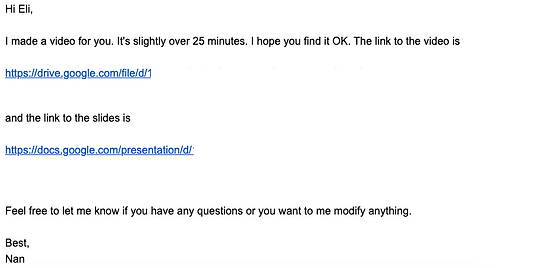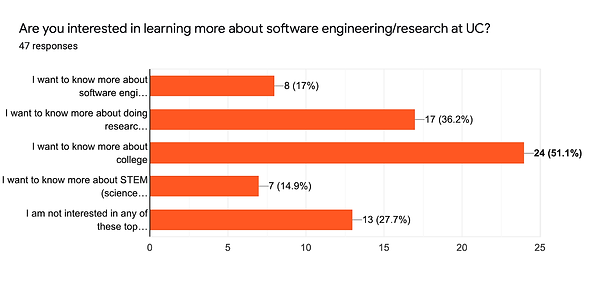UC Professor
Students and their families have been exposed to people, programs, resources, and connections that can open doors for them, and they are able to navigate and access those opportunities
Introduction
I participated in the Research Experience for Teachers Program, where I received training on the Engineering Design Process and developed units of study with fellow STEM educators. Dr. Nan Niu led my research over the summer and provided guidance as I developed a unit of study to connect my Algebra II content to research underway in engineering. Part of my job was to distill the advanced work Dr. Niu’s lab was doing and make it accessible for high school students. The goal of the program was explicitly to provide access opportunities to high school students. Everyone involved on the UC side of the project signed on with the intention of working with my students to expose them to careers in STEM fields. I worked with a team of other high school STEM teachers, researchers, and education specialists at the University of Cincinnati to create a unit that introduced students to college-level work through the Engineering Design Process.
The goal of this unit and of Dr. Niu's visit was to make students feel competent and capable of pursuing STEM fields. The Engineering Design Process was taught to students through the unit, giving students the tools and thought processes necessary for academic success after high school. Dr. Niu’s visit provided grounding for the abstract work we did in class and opened the door to a field they’ve never been exposed to. His interactions with my students helped them navigate the college and career readiness work I have done with them throughout the year.
Table of Contents
Stem exposure Unit Plan
Unit Design
The major focuses of the National Science Foundation grant behind the program I worked for were iterative design through the Engineering Design Process and communication of complex ideas. This unit tied both of those aspects together. I collaborated with Dr. Niu, other University of Cincinnati professors, and other high school STEM teachers in the development of this unit. This broguht together a team of 10+ educators all with a vested interest in connecting my students to STEM careers.
My research over the summer centered on using human intuition to develop algorithms for hacking into web applications. Decision making in complex and multilayered situations was the topic of interest, and my unit design extrapolated from that idea. Students used the Engineering Design Process to tackle a simulated national health crisis. They were tasked with generating the best solution available and creating effective means of communicating their answer. The unit materials created over the summer are attached below. More information can be found on the RET@UC website, found here.
Career Exploration
In this unit that I planned with educators at the University of Cincinnati, students were responsible for exploring careers in the health sciences. Many of my students have expressed interest in pursuing nursing, but they lack a clear vision of what the career looks like or how they can begin. This portion of the project helped students explore college majors and careers in the health sciences, especially when it comes to the Center for Disease Control and Prevention (CDC). The unit dealt with a hypothetical outbreak in the United States, and students were tasked with researching the CDC's role in addressing them and learning how they can prepare for a career in the field. Three students' responses are included in the PDF below.
This portion of the unit provided access to my students. I learned from experts in the field during the creation of this learning experience, and I was able to help connect my students to resources where they could learn more about careers in the health sciences. This assignment wrapped up of my side of the project and my role going forward was to connect students to researchers and students at UC that could answer students' individual questions.
Virtual Classroom Visit
Planning a Visit
This unit exposed students to college opportunities at a surface level, and I wanted them to be able to dive deeper. I invited Dr. Niu to come speak to my students, originally intending for him to come after students took the ACT on March 10th. The plan changed significantly due to COVID-19, but I worked with Dr. Niu to provide an online learning experience similar to the one we planned together over the summer.
My students are generally aware of the University of Cincinnati, but they are unfamiliar with how universities are structured and what it looks like to be a student there. Part of my focus with this visit is that students are exposed to a new field of study, but the real benefit I expect students to draw from this experience is more insight into a college education. My students have spend a considerable amount of time exploring careers and college majors, and Dr. Niu's visit provides a tangible point of reference for that abstract learning. He is currently a professor at a college nearby, but students are unlikely to have considered seeking his assistance nor exploring his field of research.

The original plan had to be adapted to account for the shift to distance learning in March. I reached out to Dr. Niu with some ideas of how this access opportunity would accommodate the new learning environment.
Dr. Niu and I spoke on the phone about how best to connect students to resources and knowledge that will open doors for them. We discussed what content would be helpful to students and how he could serve as a resource for students to learn more about college. The goal we laid out is that he introduce students to the foundation of higher education by explaining the purpose and practice of research at the collegiate level. Students would learn why college is significant in a broad sense before diving into the more specific research that Dr. Niu conducts. His work is in the field of software engineering, and he planned to speak to the application of his work in the real world. This would open students to an entirely new field of academics that they otherwise would not have known about.

Dr. Niu shared his video and slides over email.
Dr. Niu was not able to attend my classroom in person due to the COVID-19 outbreak, but he recorded a video of the presentation he was going to deliver. He offered insight into his research topics and related his work to the real world. At the end, he gave students a computer science problem to explore and think about. This showed students a potential future for them to pursue and gave them an opportunity to engage with the work tangibly.
Dr. Niu created a video that reviewed the research he conducts at the University of Cincinnati. At the end, he shares a problem for students to engage with and think about.
Dr. Niu shared the slideshow so that students could follow along with the video.
These materials were posted in my Google Classroom. Students were given time to watch the video and submit questions for Dr. Niu to answer. They were introduced to new opportunities, and this follow-up helped them to navigate their exploration. I asked students what stood out to them in the video presentation and asked them to identify what they want to know more about. Few of my students have met someone who works at a college before, so they naturally wanted to know more about college itself. Students were similarly drawn to learn more about research. They submitted questions to Dr, Niu so they could learn more about the opportunities they were considering.

Students' responses here help me summarize the questions students submitted. It gave Dr. Niu and I an idea of what students were drawn to in the video presentation. I tried my best to encapsulate students' needs in the questions I submitted to Dr. Niu.
Students inquired about things in the presentation that interested them. They had a lot of questions about college in general and wanted to know more about Dr. Niu's journey to working at the University of Cincinnati.
I summarized some of the questions that repeatedly came up in students' submissions to share with Dr. Niu. I did not want him to have to read the 150+ questions submitted by my students, so I condensed the gist of them into 5 questions that would answer most students' questions.

I emailed a short list of questions to Dr. Niu that captured what students wanted to know more about. I wrote these questions myself so that fewer questions could address more students' questions. They are more broad, but they capture what students were captivated by.
Dr. Niu provided his answers in a follow-up email. He spoke to and connected students to the college experience at The University of Cincinnati. He offered some insight that will help students navigate the access he provided by exposing them to his research and experience.
His answers offered some students clarity in their decision-making around attending college. Speaking to a professor about their college concerns helped them consider where they fit. For some students who weren't interested in attending college, Dr. Niu's research provided some reassurance that they have chosen the right path. For others, it excited them and they are more interested in pursuing a field related to software engineering. Regardless of the direction they go, students are more informed about the options available to them and are more capable of taking advantage of the resources and opportunities afforded to them. If Dr. Niu's presentation was unappealing, students now know that software engineering might not be for them and they can comfortably explore other options knowing that they aren't missing out on a high-paying career that they wouldn't enjoy. Other students are intrigued and want to know more about their options for exploring computer science related fields.
Conclusion
My work with the University of Cincinnati over the summer connected me to professors and researchers interested in improving access to opportunities for students like mine. I was trained on building connections between content taught in high school math classrooms to broader academic applications. I worked with several collaborators, including STEM education experts, engineering professors, and math content experts to craft experiences that open doors for my students by minimizing the barrier between high school and university classrooms. My students were given tangible experience with what it is like to be a college student in highly sought after fields like computer science and engineering. The oftentimes hidden curriculum of communicating technical information effectively was brought to the forefront to better prepare students for academic success beyond high school.
My school has a defeatist culture when it comes to post-graduation plans. Students have the impression that they won’t be successful in college, so they resign themselves to “safe careers” in the trades. There is not anything wrong with pursuing welding, but none of my students should feel like that is their only option. This experience gave students insight into an opportunity available to them that they would not have known about without me being their teacher. They participated in an educational experience crafted with an engineering professor that introduced them to college level work and STEM careers at large. Then, they got to meet virtually with a professor to engage in conversations about concerns on their mind about college. They know more about the careers available to them and now have the tools to take advantage of their resources.